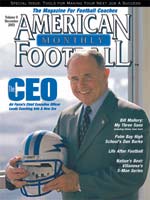AMERICAN FOOTBALL MONTHLY THE #1 RESOURCE FOR FOOTBALL COACHES
Article CategoriesAFM Magazine
|
Vilanova\'s 5-man Protection SeriesWide Receivers, Villanova© More from this issue Over the past six seasons, Villanova University has thrown for over 20,000 yards. One aspect we stress is constantly attempting to stretch the defenses that we see both vertically and horizontally. We will try to force the opposition to cover the entire field. We will do this by incorporating multiple formations and personnel groupings. We will also attempt to stress the defense by having the ability to get into several formations from the same personnel group. For example, we will jump to a No-Back look from our 1-Tight End/2-Back personnel. Everything we do game plan-wise is in an effort to constantly stress the defensive coverages and attack those stretched seams. One of the pac....The full article can only be seen by subscribers. Subscribe today!
|
|
|||||||
| HOME |
MAGAZINE |
SUBSCRIBE | ONLINE COLUMNISTS | COACHING VIDEOS |
Copyright 2025, AmericanFootballMonthly.com
All Rights Reserved





